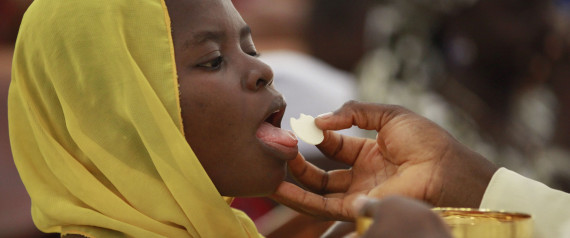
14. The Eucharistic Liturgy
The Catholic term ”Liturgy" derives from the Greek word leitourgia, which means "a public duty" or "a public action?" This meaning took on a religious connotation in regard to the public ministrations of the Old Testament priests in the Temple (cf. Exodus 38:27, 39:12; Joel 1:9, 2:17; where the term leitourgeo is used in the Greek, Septuagint, version). The ancient Tradition of the Liturgy has been taught and believed by Christians since the days of Christ. Latin Rite Catholics are accustomed to referring to it as the "Mass," while Eastern Catholics call it the "Divine Liturgy." Both refer to the same doctrine.
Since the night Christ was betrayed, the Catholic Church has been celebrating the Liturgy of the Eucharist. This is part of Sacred Tradition, a revealed doctrine of the Faith that came from Christ himself and was preached and taught by the Apostles and their successors from the earliest days of the Church. About the year 56, St. Paul wrote about this Tradition and of how important it was to the life of the Church:
"I praise you because you remember me in everything and hold fast to the traditions, just as I handed them on to you "
For the first few centuries, the Eucharistic Liturgy was not a formally codified ritual as we know it today, though it was universally celebrated in the East and West with its essential elements and according to the particular meaning the Catholic Church has always understood it to contain: the once-for-all sacrifice of Christ on the cross, re-presented in time and space.
The Catechism explains the Church’s meaning when it refers to the Church’s Tradition of the Eucharistic Liturgy, defining it to mean:
An action of thanksgiving to God (CCC 1328);From these explanatory sections from the Catechism, we can see the essential elements of the Tradition of the Eucharistic Liturgy. This has been an ever-present, ubiquitous Tradition in the Church since the time of Christ and the Apostles. What makes this Tradition so powerful when a Catholic dialogues with Protestants is that it is undeniable that the early Christians did not gather for a "Sunday service," as Protestants typically understand the term. Rather, the early Christians gathered together to celebrate the Eucharistic sacrifice, complete with the essential prayers and gestures we use today in the Catholic Church (as well as in the Eastern Catholic and Orthodox Churches).
The Lord’s Supper (CCC 1329; cf. 1 Corinthians 11:20; Revelation 19:9);
The Breaking of Bread (CCC 1329; cf. Matthew 14:19,15:36,26:26; Mark 8:6, 19.);
The Eucharistic assembly (CCC 1329; cf. 1 Corinthians 11:17-34);
The memorial of the Lord’s Passion and Resurrection (CCC 1330);
A Holy Sacrifice (CCC 1330; cf. Hebrews 13:15; cf. 1 Peter 2:5; Psalm116:13, 17; Malachi 1:11);
The Holy and Divine Liturgy;
Holy Communion (CCC 1331; cf. 1 Corinthians 10: 16-17);
Holy Mass (CCC 1332).


No comments:
Post a Comment